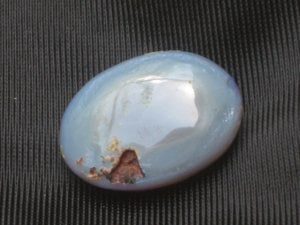I recently acquired this stone. It was described to me as an 'oval cut cab stone 29mm x 19 x 10mm, translucent light brown with moderate violet small flask pattern'. I am not totally convinced it is nothing more than plastic to be honest, but thought I'd see what you all had to say. The pictures don't do it justice as the flecks look blue in the photos, but are actually bright purple. What concerns me is the back of it. It almost looks like some kind of coating. It is clear by the markings on the back that it was glued into/onto something, but then there's the chunk that looks rock-like. Any ideas?







300x240.png)